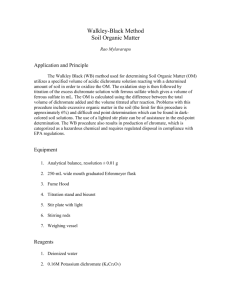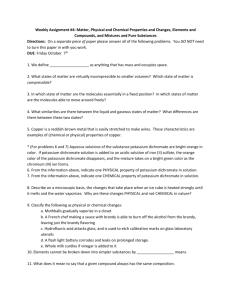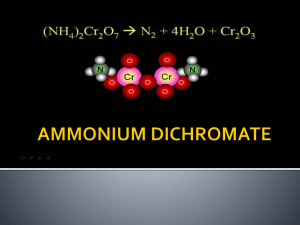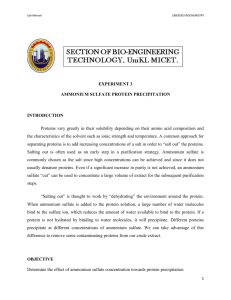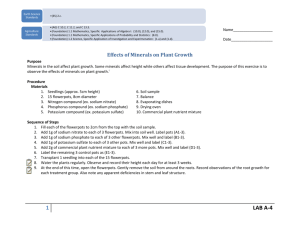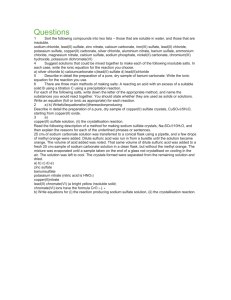file2
advertisement
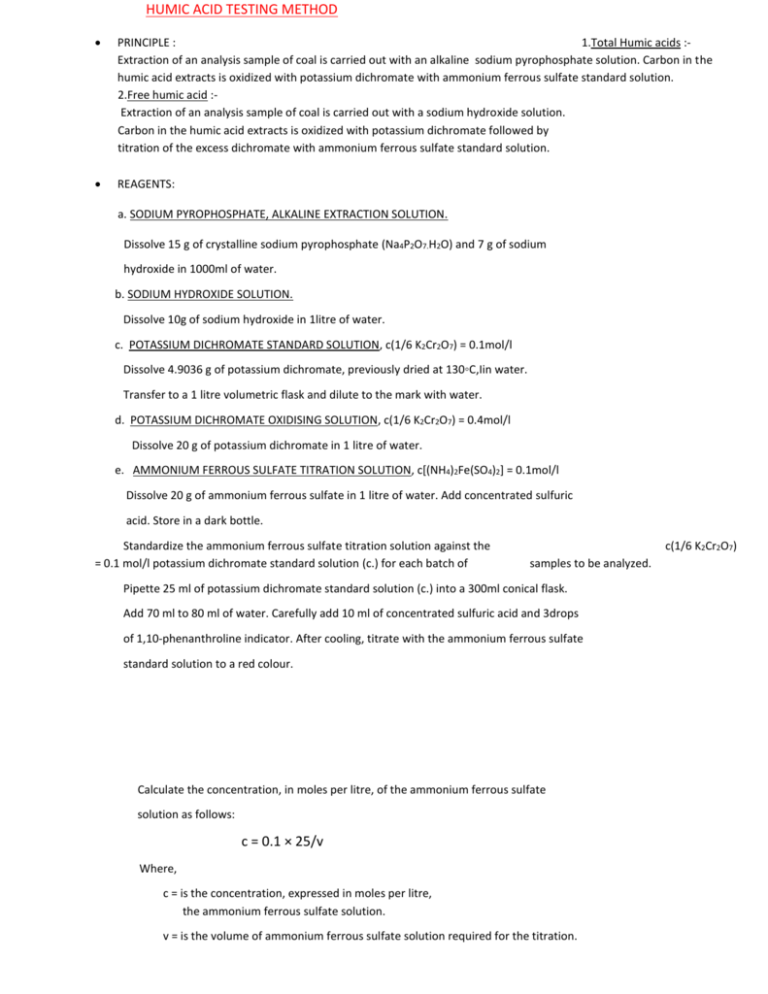
HUMIC ACID TESTING METHOD PRINCIPLE : 1.Total Humic acids :Extraction of an analysis sample of coal is carried out with an alkaline sodium pyrophosphate solution. Carbon in the humic acid extracts is oxidized with potassium dichromate with ammonium ferrous sulfate standard solution. 2.Free humic acid :Extraction of an analysis sample of coal is carried out with a sodium hydroxide solution. Carbon in the humic acid extracts is oxidized with potassium dichromate followed by titration of the excess dichromate with ammonium ferrous sulfate standard solution. REAGENTS: a. SODIUM PYROPHOSPHATE, ALKALINE EXTRACTION SOLUTION. Dissolve 15 g of crystalline sodium pyrophosphate (Na4P2O7.H2O) and 7 g of sodium hydroxide in 1000ml of water. b. SODIUM HYDROXIDE SOLUTION. Dissolve 10g of sodium hydroxide in 1litre of water. c. POTASSIUM DICHROMATE STANDARD SOLUTION, c(1/6 K2Cr2O7) = 0.1mol/l Dissolve 4.9036 g of potassium dichromate, previously dried at 130◦C,Iin water. Transfer to a 1 litre volumetric flask and dilute to the mark with water. d. POTASSIUM DICHROMATE OXIDISING SOLUTION, c(1/6 K2Cr2O7) = 0.4mol/l Dissolve 20 g of potassium dichromate in 1 litre of water. e. AMMONIUM FERROUS SULFATE TITRATION SOLUTION, c[(NH4)2Fe(SO4)2] = 0.1mol/l Dissolve 20 g of ammonium ferrous sulfate in 1 litre of water. Add concentrated sulfuric acid. Store in a dark bottle. Standardize the ammonium ferrous sulfate titration solution against the = 0.1 mol/l potassium dichromate standard solution (c.) for each batch of c(1/6 K2Cr2O7) samples to be analyzed. Pipette 25 ml of potassium dichromate standard solution (c.) into a 300ml conical flask. Add 70 ml to 80 ml of water. Carefully add 10 ml of concentrated sulfuric acid and 3drops of 1,10-phenanthroline indicator. After cooling, titrate with the ammonium ferrous sulfate standard solution to a red colour. Calculate the concentration, in moles per litre, of the ammonium ferrous sulfate solution as follows: c = 0.1 × 25/v Where, c = is the concentration, expressed in moles per litre, the ammonium ferrous sulfate solution. v = is the volume of ammonium ferrous sulfate solution required for the titration. f. 1,10-PHENANTHROLINE INDICATOR. Dissolve 1.5g of 1,10-phenanthroline and 1 g of ammonium ferrous sulfate in 100ml of Store in a dark bottle. water. g. Sulfuric acid, concentrated, ρ20 = 1.84g/ml APPARATUS : 1. Water bath, thermostatically controlled to (100 ± 1) ◦C, with four holes at least. 2. Balance, sensitive to 0.1mg. SAMPLE : Prepare the sample for the determination of humic acids in accordance with clause 8 "sample preparation for general analysis" of ISO 5069-2:1983. For calculation to a dry basis, the moisture in the analysis sample shall be determined according to ISO 5068 or ISO 1015. PROCEDURE : A. EXRACTION OF TOTAL HUMIC ACIDS Weigh (0.2 ± 0.0002) g of analysis sample into a conical flask. Add 150 ml of alkaline sodium pyrophosphate extraction solution (a.) and mix until the sample is thoroughly wetted. Place a small funnel on the flask and heat in the boiling water bath (1.) for 2h, shaking frequently to ensure precipitation of insoluble material. Remove the flask from the water bath. Allow to cool to room temperature and quantitatively transfer the extract and residue to a 200ml volumetric flask. Dilute to the mark with water and shake to ensure through mixing. Determine the total humic acids (w ) extracted by alkaline sodium pyrophosphate as specified in (C.). HA,t B. EXTRACTION OF FREE HUMIC ACID. Weigh (0.2 ± 0.0002)g of analysis sample into a conical flask. Add 150 ml of sodium hydroxide extraction solution (b.) and mix until the sample is thoroughly wetted. Place a small funnel on the flask and heat in the boiling water bath (1.) for 2h, shaking frequently to ensure through mixing. Remove the flask from the water bath. Allow to cool to room temperature and quantitatively transfer the extract and residue to a 200ml volumetric flask using water. Dilute to the mark with water and shake to ensure through mixing Determine the free humic acids (w ) extracted by sodium hydroxide as specified in (C.). HA,f C. DETERMINATION OF HUMIC ACIDS IN EXTRACTS. C.1. OXIDATION OF EXTRACTS. Pipette 5 ml of clarified or dry-filtered extract into a 250 ml to 300ml conical flask. Pipette 5 ml of potassium dichromate oxidizing solution (d.) into the flask. Carefully add 15 ml of concentrated sulfuric acid (g.). Place in the boiling water bath (1.) and heat for 30 min. Allow to cool to room temperature. Dilute to approximately 100 ml. C.2. TITRATION OF EXTRACTS. Add 3 drops of 1,10-phenanthroline indicator (f.) to the solution from (C.1.) and tirate with the ammonium ferrous sulfate solution (e.) to a brick red colour. C.3. BLANK. C.3.a. BLANK FOR TOTAL HUMIC ACIDS. Pipette 5 ml of sodium pyrophosphate (a.) into a 250 ml to 300 ml conical flask, add the potassium dichromate oxidizing solution (d.) and the concentrated sulfuric acid as specified in C.1. and carry out the titration as specified in C.2. C.3.b. BLANK FOR FREE HUMIC ACIDS. Pipette 5 ml of sodium hydroxide (b.) into a 250 ml to 300 ml conical flask, add the potassium dichromate oxidizing solution (d.) and the concentrated sulfuric acid as specified in C.1. and carry out the titration as specified in C.2. EXPRESSION OF RESULTS : Calculate the total humic acid content (w ) or free humic acid content (w ), as a percentage by mass, of the HA,t HA,f sample as analysed according to the following formula : w HA = [(v0 – v1 ) × 0.003 × c] / [0.59 × m] × [ve/va ] × 100 where, 0.003 = is the millimole mass of carbon, in grams per millimole; v0 = is the volume of the ammonium ferrous sulfate titration solution used in the blank titre, in mililitres; v1= is the volume of the ammonium ferrous sulfate titration solution used in the extract titre in mililitres; c = is the concentration of the ammonium ferrous sulfate extraction solution as determiced in (e.) in moles per litre; ve = is the volume of the extract, in milliliters; va = is the volume of the aliquot taken for titration , in milliliters; 0.59 = is the average ratio of carbon content of humic acids for brown coals and lignites. m = is the mass of the sample taken for the test, in grams.
